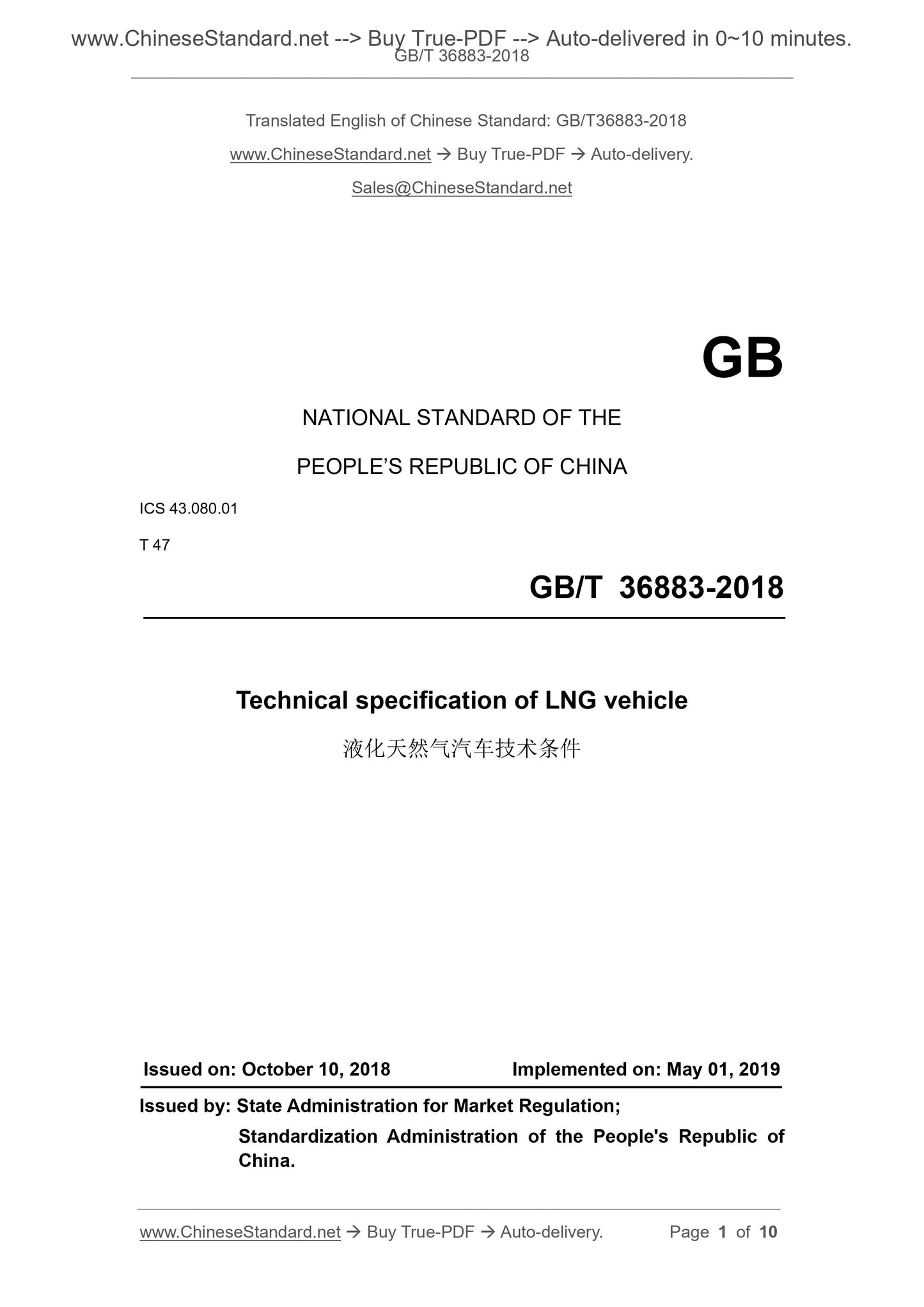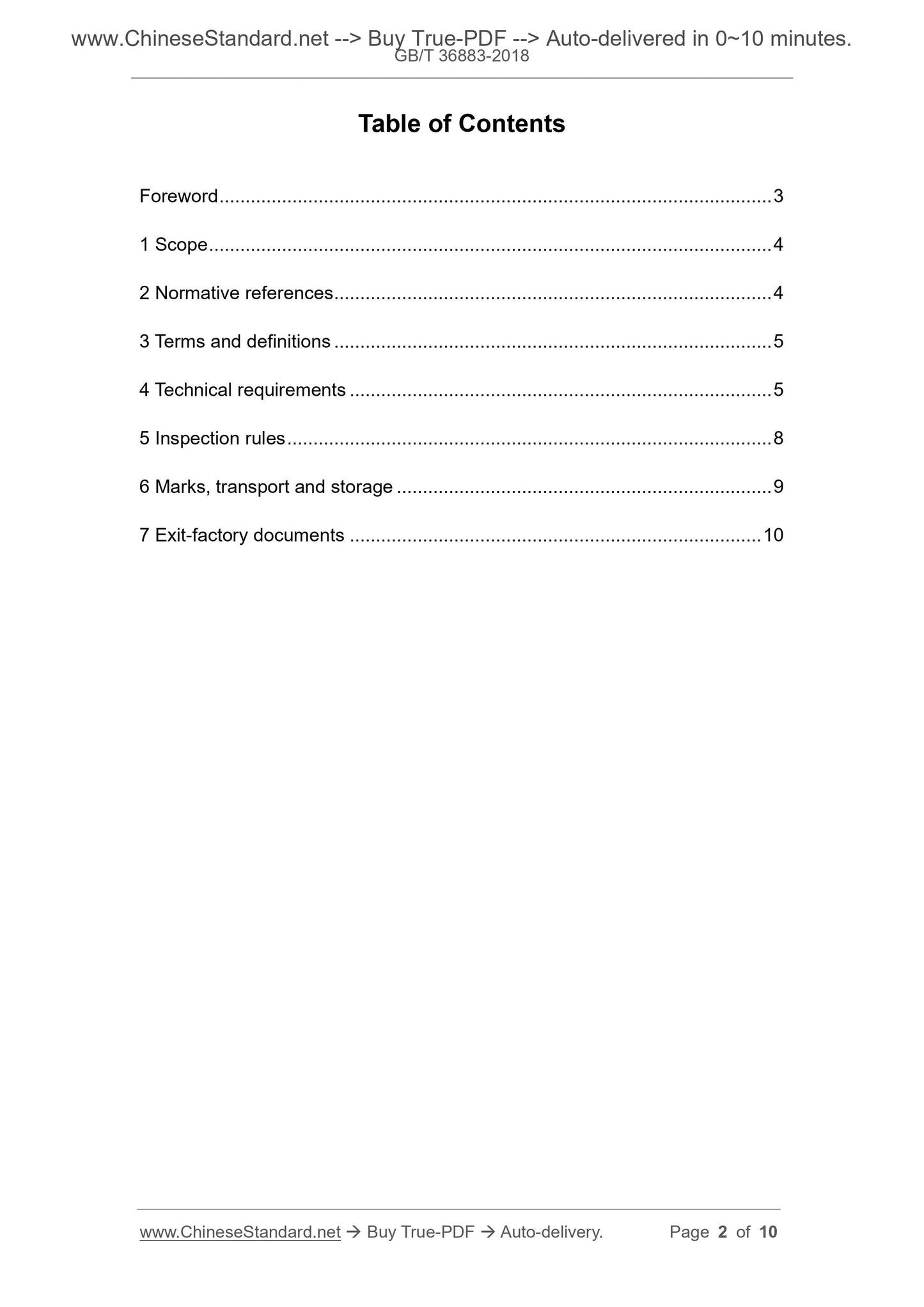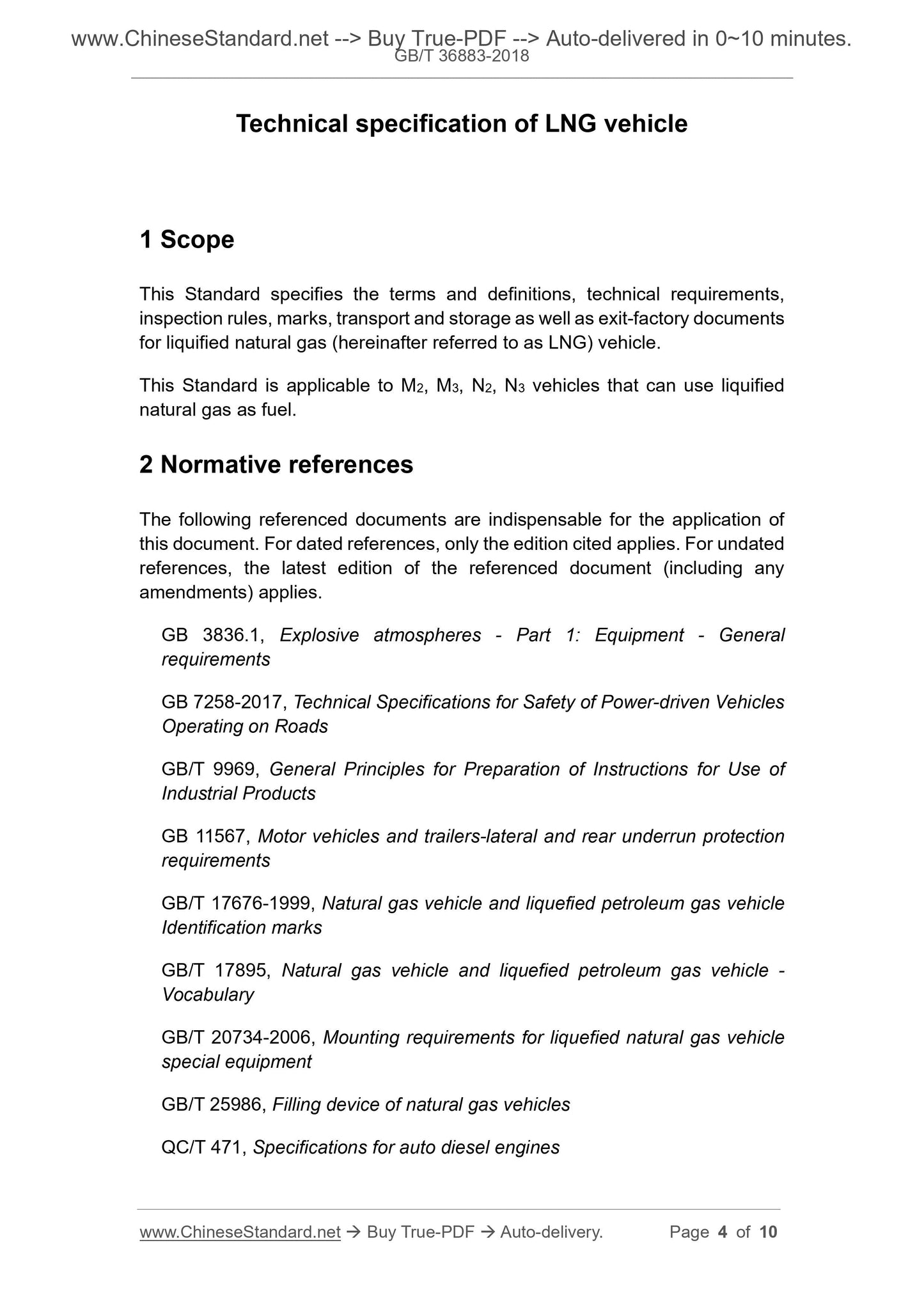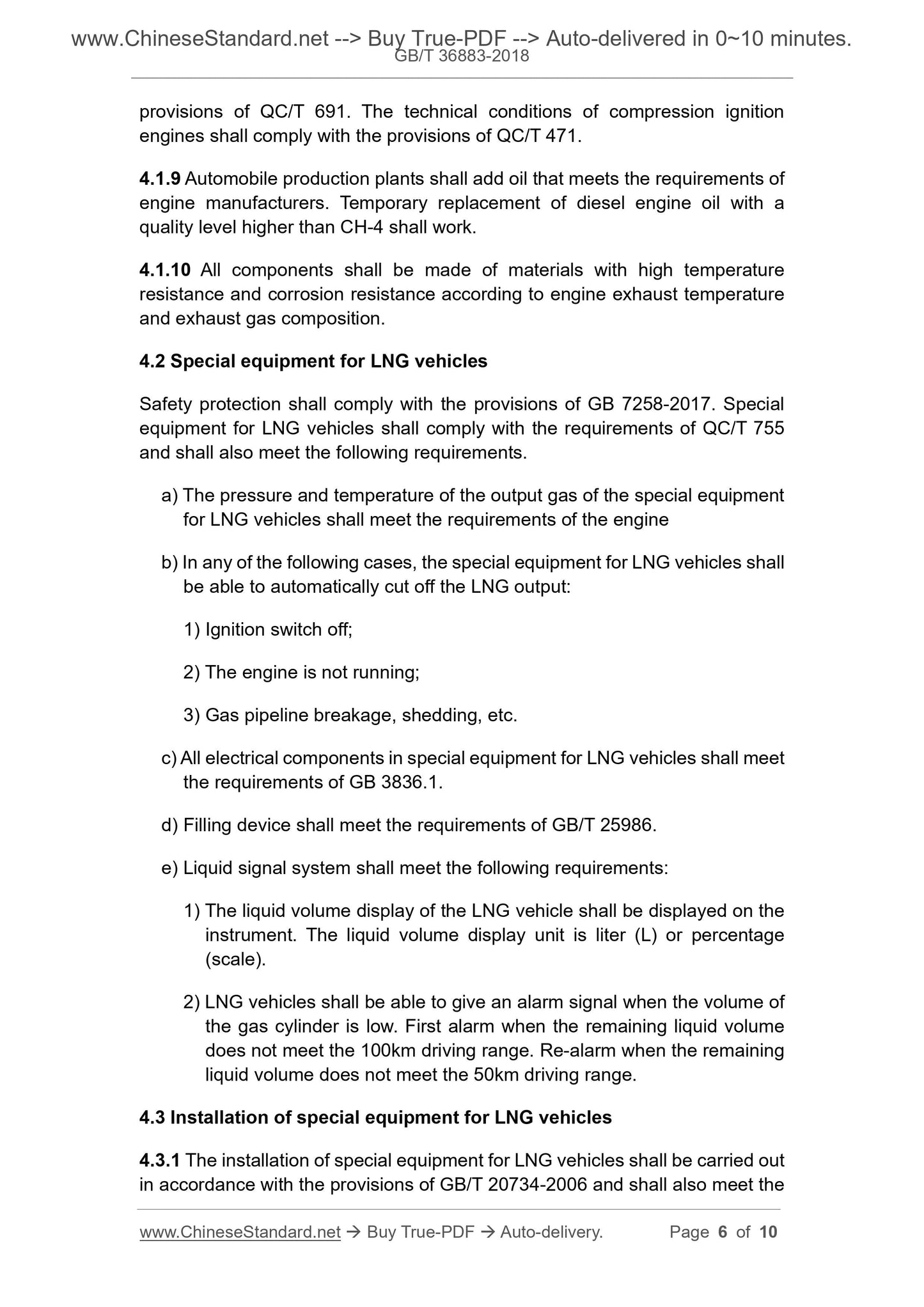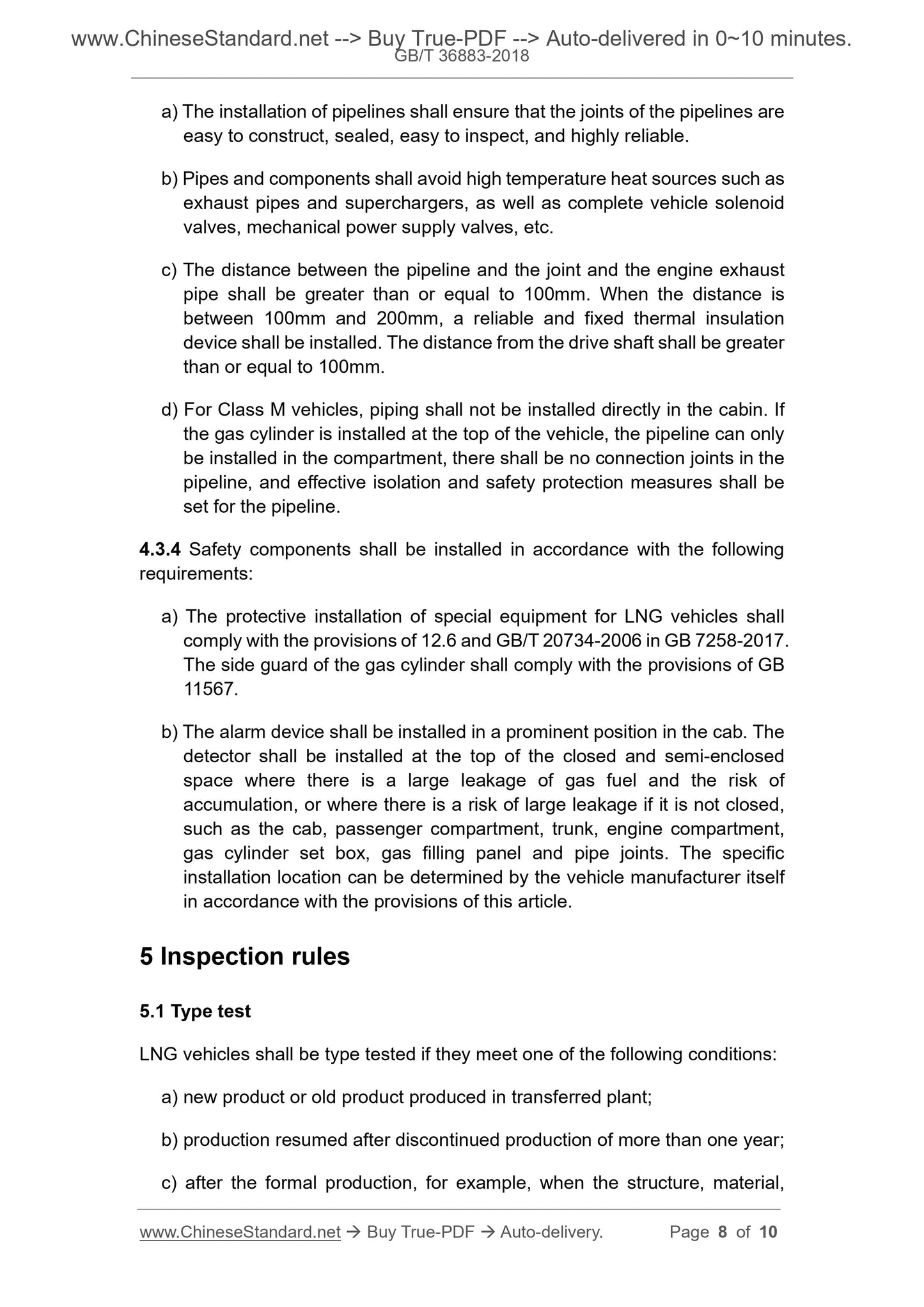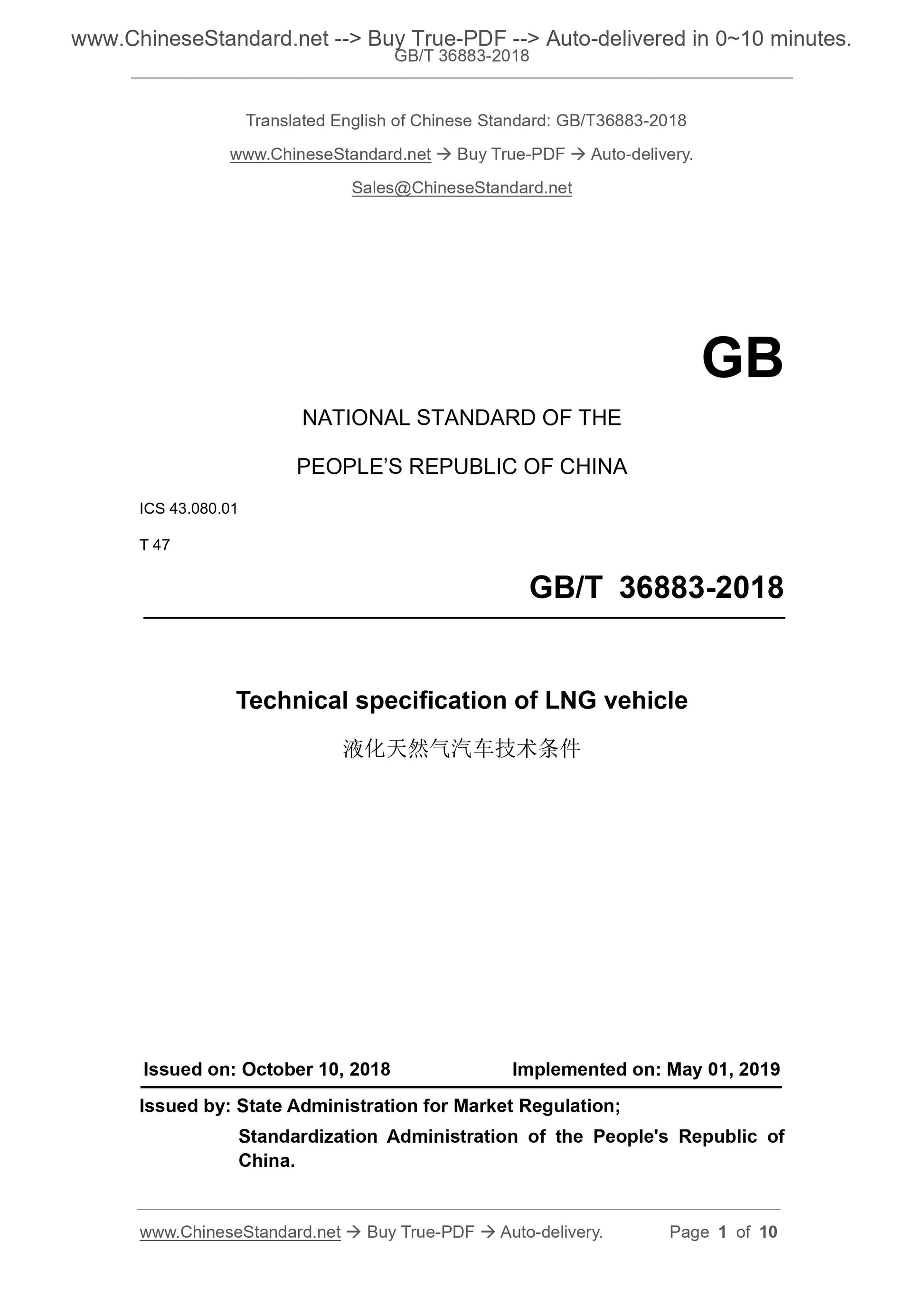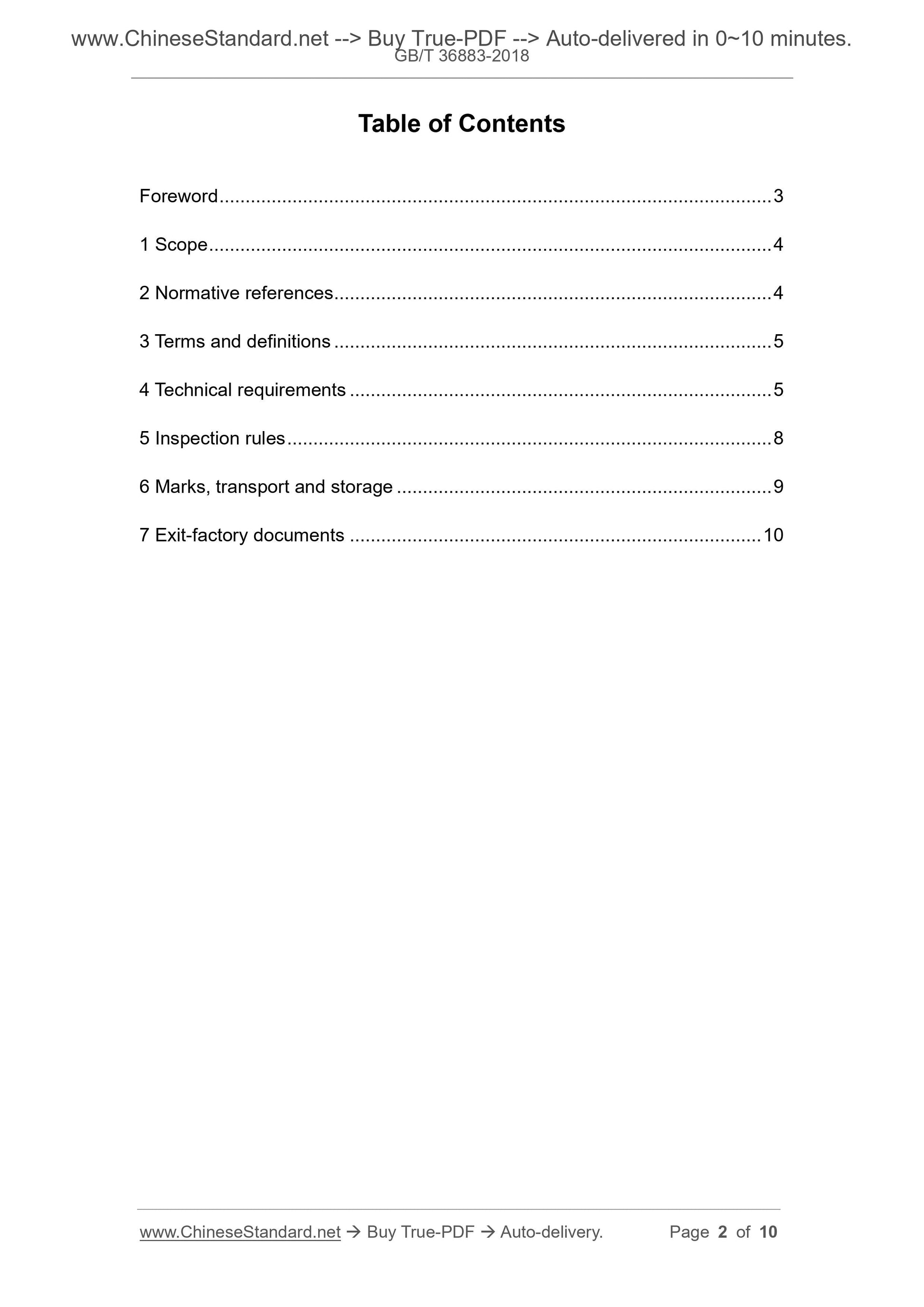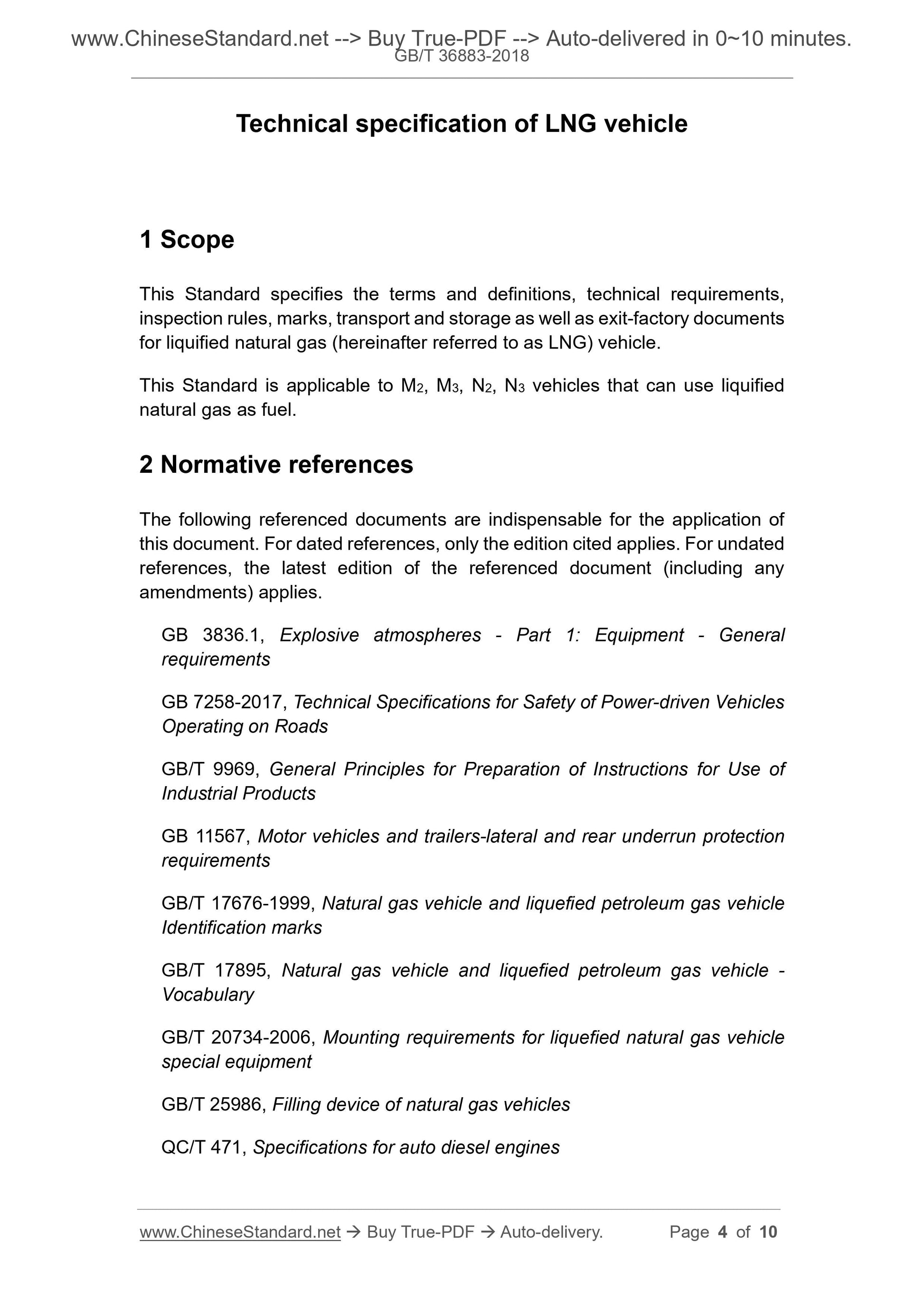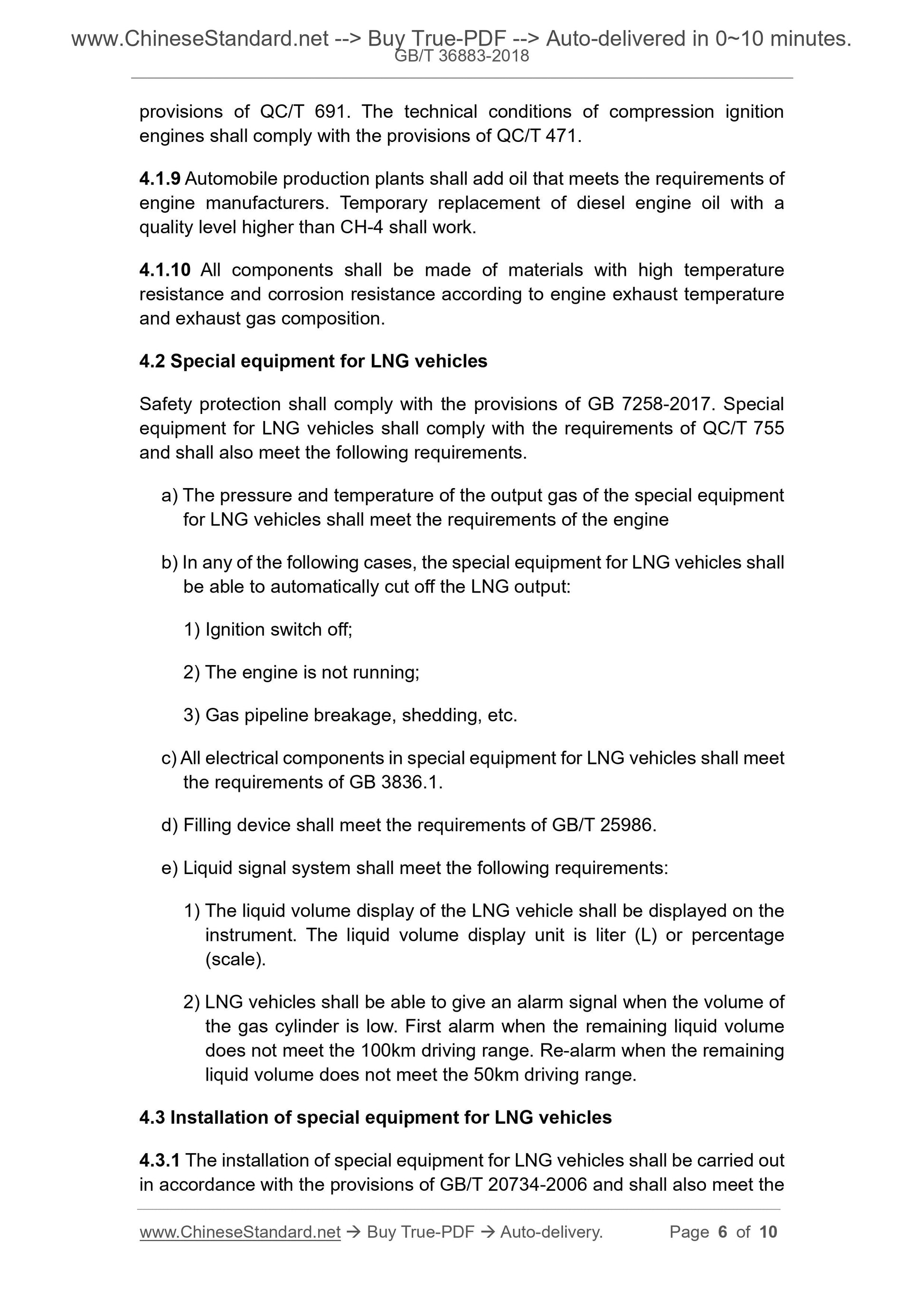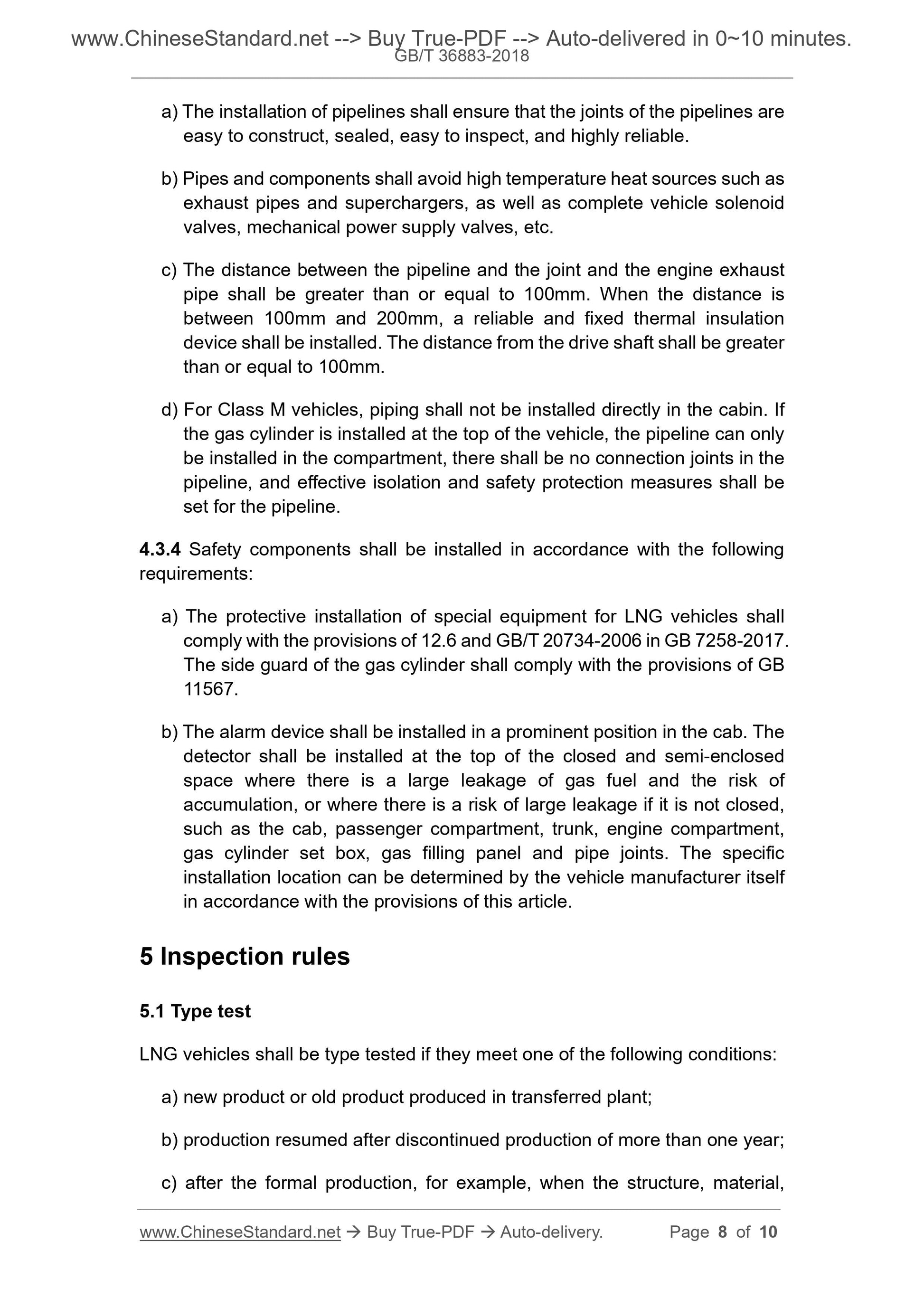1
/
von
5
PayPal, credit cards. Download editable-PDF & invoice In 1 second!
GB/T 36883-2018 English PDF (GBT36883-2018)
GB/T 36883-2018 English PDF (GBT36883-2018)
Normaler Preis
$85.00 USD
Normaler Preis
Verkaufspreis
$85.00 USD
Grundpreis
/
pro
Versand wird beim Checkout berechnet
Verfügbarkeit für Abholungen konnte nicht geladen werden
Delivery: 3 seconds. Download true-PDF + Invoice.
Get QUOTATION in 1-minute: Click GB/T 36883-2018
Historical versions: GB/T 36883-2018
Preview True-PDF (Reload/Scroll if blank)
GB/T 36883-2018: Technical specification of LNG vehicle
GB/T 36883-2018
GB
NATIONAL STANDARD OF THE
PEOPLE’S REPUBLIC OF CHINA
ICS 43.080.01
T 47
Technical specification of LNG vehicle
ISSUED ON. OCTOBER 10, 2018
IMPLEMENTED ON. MAY 01, 2019
Issued by. State Administration for Market Regulation;
Standardization Administration of the People's Republic of
China.
Table of Contents
Foreword ... 3
1 Scope ... 4
2 Normative references ... 4
3 Terms and definitions ... 5
4 Technical requirements ... 5
5 Inspection rules ... 8
6 Marks, transport and storage ... 9
7 Exit-factory documents ... 10
Technical specification of LNG vehicle
1 Scope
This Standard specifies the terms and definitions, technical requirements,
inspection rules, marks, transport and storage as well as exit-factory documents
for liquified natural gas (hereinafter referred to as LNG) vehicle.
This Standard is applicable to M2, M3, N2, N3 vehicles that can use liquified
natural gas as fuel.
2 Normative references
The following referenced documents are indispensable for the application of
this document. For dated references, only the edition cited applies. For undated
references, the latest edition of the referenced document (including any
amendments) applies.
GB 3836.1, Explosive atmospheres - Part 1. Equipment - General
requirements
GB 7258-2017, Technical Specifications for Safety of Power-driven Vehicles
Operating on Roads
GB/T 9969, General Principles for Preparation of Instructions for Use of
Industrial Products
GB 11567, Motor vehicles and trailers-lateral and rear underrun protection
requirements
GB/T 17676-1999, Natural gas vehicle and liquefied petroleum gas vehicle
Identification marks
GB/T 17895, Natural gas vehicle and liquefied petroleum gas vehicle -
Vocabulary
GB/T 20734-2006, Mounting requirements for liquefied natural gas vehicle
special equipment
GB/T 25986, Filling device of natural gas vehicles
QC/T 471, Specifications for auto diesel engines
provisions of QC/T 691. The technical conditions of compression ignition
engines shall comply with the provisions of QC/T 471.
4.1.9 Automobile production plants shall add oil that meets the requirements of
engine manufacturers. Temporary replacement of diesel engine oil with a
quality level higher than CH-4 shall work.
4.1.10 All components shall be made of materials with high temperature
resistance and corrosion resistance according to engine exhaust temperature
and exhaust gas composition.
4.2 Special equipment for LNG vehicles
Safety protection shall comply with the provisions of GB 7258-2017. Special
equipment for LNG vehicles shall comply with the requirements of QC/T 755
and shall also meet the following requirements.
a) The pressure and temperature of the output gas of the special equipment
for LNG vehicles shall meet the requirements of the engine
b) In any of the following cases, the special equipment for LNG vehicles shall
be able to automatically cut off the LNG output.
1) Ignition switch off;
2) The engine is not running;
3) Gas pipeline breakage, shedding, etc.
c) All electrical components in special equipment for LNG vehicles shall meet
the requirements of GB 3836.1.
d) Filling device shall meet the requirements of GB/T 25986.
e) Liquid signal system shall meet the following requirements.
1) The liquid volume display of the LNG vehicle shall be displayed on the
instrument. The liquid volume display unit is liter (L) or percentage
(scale).
2) LNG vehicles shall be able to give an alarm signal when the volume of
the gas cylinder is low. First alarm when the remaining liquid volume
does not meet the 100km driving range. Re-alarm when the remaining
liquid volume does not meet the 50km driving range.
4.3 Installation of special equipment for LNG vehicles
4.3.1 The installation of special equipment for LNG vehicles shall be carried out
in accordance with the provisions of GB/T 20734-2006 and shall also meet the
a) The installation of pipelines shall ensure that the joints of the pipelines are
easy to construct, sealed, easy to inspect, and highly reliable.
b) Pipes and components shall avoid high temperature heat sources such as
exhaust pipes and superchargers, as well as complete vehicle solenoid
valves, mechanical power supply valves, etc.
c) The distance between the pipeline and the joint and the engine exhaust
pipe shall be greater than or equal to 100mm. When the distance is
between 100mm and 200mm, a reliable and fixed thermal insulation
device shall be installed. The distance from the drive shaft shall be greater
than or equal to 100mm.
d) For Class M vehicles, piping shall not be installed directly in the cabin. If
the gas cylinder is installed at the top of the vehicle, the pipeline can only
be installed in the compartment, there shall be no connection joints in the
pipeline, and effective isolation and safety protection measures shall be
set for the pipeline.
4.3.4 Safety components shall be installed in accordance with the following
requirements.
a) The protective installation of special equipment for LNG vehicles shall
comply with the provisions of 12.6 and GB/T 20734-2006 in GB 7258-2017.
The side guard of the gas cylinder shall comply with the provisions of GB
11567.
b) The alarm device shall be installed in a prominent position in the cab. The
detector shall be installed at the top of the closed and semi-enclosed
space where there is a large leakage of gas fuel and the risk of
accumulation, or where there is a risk of large leakage if it is not closed,
such as the cab, passenger compartment, trunk, engine compartment,
gas cylinder set box, gas filling panel and pipe joints. The specific
installation location can be determined by the vehicle manufacturer itself
in accordance with the provisions of this article.
5 Inspection rules
5.1 Type test
LNG vehicles shall be type tested if they meet one of the following conditions.
a) new product or old product produced in transferred plant;
b) production resumed after discontinued production of more than one year;
c) after the formal production, for example, when the structure, material,
Get QUOTATION in 1-minute: Click GB/T 36883-2018
Historical versions: GB/T 36883-2018
Preview True-PDF (Reload/Scroll if blank)
GB/T 36883-2018: Technical specification of LNG vehicle
GB/T 36883-2018
GB
NATIONAL STANDARD OF THE
PEOPLE’S REPUBLIC OF CHINA
ICS 43.080.01
T 47
Technical specification of LNG vehicle
ISSUED ON. OCTOBER 10, 2018
IMPLEMENTED ON. MAY 01, 2019
Issued by. State Administration for Market Regulation;
Standardization Administration of the People's Republic of
China.
Table of Contents
Foreword ... 3
1 Scope ... 4
2 Normative references ... 4
3 Terms and definitions ... 5
4 Technical requirements ... 5
5 Inspection rules ... 8
6 Marks, transport and storage ... 9
7 Exit-factory documents ... 10
Technical specification of LNG vehicle
1 Scope
This Standard specifies the terms and definitions, technical requirements,
inspection rules, marks, transport and storage as well as exit-factory documents
for liquified natural gas (hereinafter referred to as LNG) vehicle.
This Standard is applicable to M2, M3, N2, N3 vehicles that can use liquified
natural gas as fuel.
2 Normative references
The following referenced documents are indispensable for the application of
this document. For dated references, only the edition cited applies. For undated
references, the latest edition of the referenced document (including any
amendments) applies.
GB 3836.1, Explosive atmospheres - Part 1. Equipment - General
requirements
GB 7258-2017, Technical Specifications for Safety of Power-driven Vehicles
Operating on Roads
GB/T 9969, General Principles for Preparation of Instructions for Use of
Industrial Products
GB 11567, Motor vehicles and trailers-lateral and rear underrun protection
requirements
GB/T 17676-1999, Natural gas vehicle and liquefied petroleum gas vehicle
Identification marks
GB/T 17895, Natural gas vehicle and liquefied petroleum gas vehicle -
Vocabulary
GB/T 20734-2006, Mounting requirements for liquefied natural gas vehicle
special equipment
GB/T 25986, Filling device of natural gas vehicles
QC/T 471, Specifications for auto diesel engines
provisions of QC/T 691. The technical conditions of compression ignition
engines shall comply with the provisions of QC/T 471.
4.1.9 Automobile production plants shall add oil that meets the requirements of
engine manufacturers. Temporary replacement of diesel engine oil with a
quality level higher than CH-4 shall work.
4.1.10 All components shall be made of materials with high temperature
resistance and corrosion resistance according to engine exhaust temperature
and exhaust gas composition.
4.2 Special equipment for LNG vehicles
Safety protection shall comply with the provisions of GB 7258-2017. Special
equipment for LNG vehicles shall comply with the requirements of QC/T 755
and shall also meet the following requirements.
a) The pressure and temperature of the output gas of the special equipment
for LNG vehicles shall meet the requirements of the engine
b) In any of the following cases, the special equipment for LNG vehicles shall
be able to automatically cut off the LNG output.
1) Ignition switch off;
2) The engine is not running;
3) Gas pipeline breakage, shedding, etc.
c) All electrical components in special equipment for LNG vehicles shall meet
the requirements of GB 3836.1.
d) Filling device shall meet the requirements of GB/T 25986.
e) Liquid signal system shall meet the following requirements.
1) The liquid volume display of the LNG vehicle shall be displayed on the
instrument. The liquid volume display unit is liter (L) or percentage
(scale).
2) LNG vehicles shall be able to give an alarm signal when the volume of
the gas cylinder is low. First alarm when the remaining liquid volume
does not meet the 100km driving range. Re-alarm when the remaining
liquid volume does not meet the 50km driving range.
4.3 Installation of special equipment for LNG vehicles
4.3.1 The installation of special equipment for LNG vehicles shall be carried out
in accordance with the provisions of GB/T 20734-2006 and shall also meet the
a) The installation of pipelines shall ensure that the joints of the pipelines are
easy to construct, sealed, easy to inspect, and highly reliable.
b) Pipes and components shall avoid high temperature heat sources such as
exhaust pipes and superchargers, as well as complete vehicle solenoid
valves, mechanical power supply valves, etc.
c) The distance between the pipeline and the joint and the engine exhaust
pipe shall be greater than or equal to 100mm. When the distance is
between 100mm and 200mm, a reliable and fixed thermal insulation
device shall be installed. The distance from the drive shaft shall be greater
than or equal to 100mm.
d) For Class M vehicles, piping shall not be installed directly in the cabin. If
the gas cylinder is installed at the top of the vehicle, the pipeline can only
be installed in the compartment, there shall be no connection joints in the
pipeline, and effective isolation and safety protection measures shall be
set for the pipeline.
4.3.4 Safety components shall be installed in accordance with the following
requirements.
a) The protective installation of special equipment for LNG vehicles shall
comply with the provisions of 12.6 and GB/T 20734-2006 in GB 7258-2017.
The side guard of the gas cylinder shall comply with the provisions of GB
11567.
b) The alarm device shall be installed in a prominent position in the cab. The
detector shall be installed at the top of the closed and semi-enclosed
space where there is a large leakage of gas fuel and the risk of
accumulation, or where there is a risk of large leakage if it is not closed,
such as the cab, passenger compartment, trunk, engine compartment,
gas cylinder set box, gas filling panel and pipe joints. The specific
installation location can be determined by the vehicle manufacturer itself
in accordance with the provisions of this article.
5 Inspection rules
5.1 Type test
LNG vehicles shall be type tested if they meet one of the following conditions.
a) new product or old product produced in transferred plant;
b) production resumed after discontinued production of more than one year;
c) after the formal production, for example, when the structure, material,
Share
